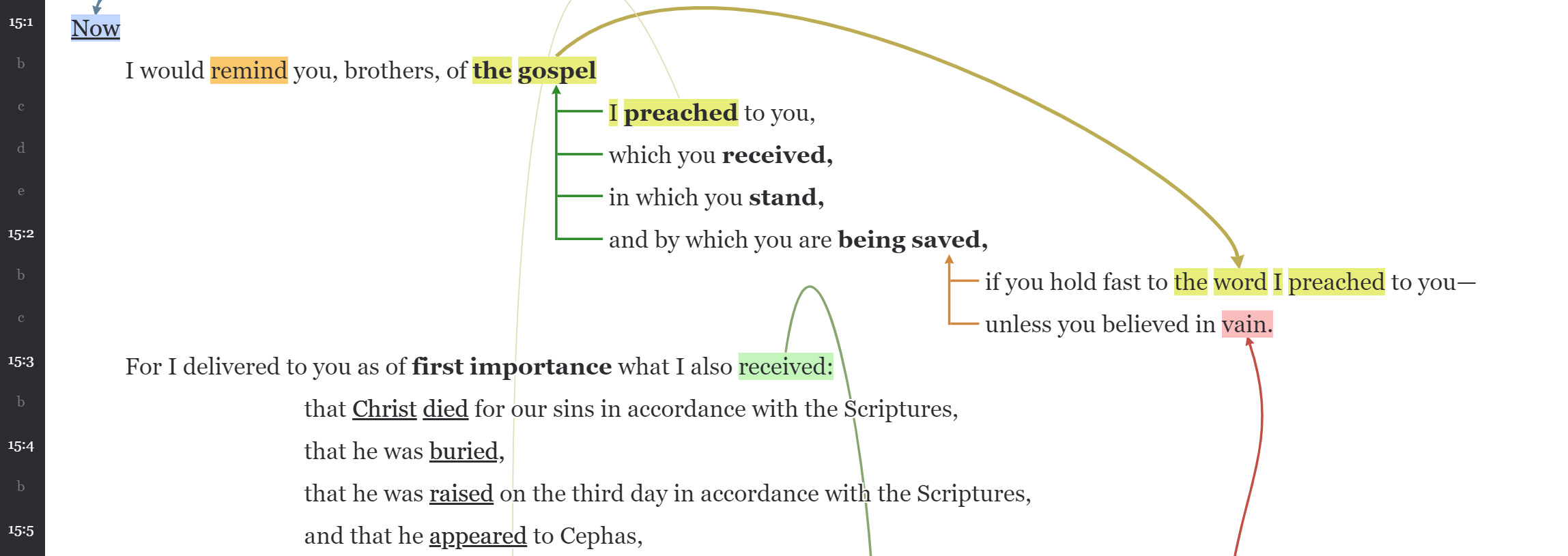Before we get into, “what is phrasing?” let us consider the importance of meditation.
Is There a Need for Meditation?
Acts 17:11 Now these Jews were more noble than those in Thessalonica; they received the word with all eagerness, examining the Scriptures daily to see if these things were so. Many of them therefore believed, with not a few Greek women of high standing as well as men.
Notice that these Jews are commended for 1) receiving the word 2) in a certain type of manner: all eagerness and they 3) examined and dissected what was being said in comparison to what they already knew from the Old Testament Scriptures. 4) Not to mention they did this “daily” to see if these things were so. 5) What was the outcome? “Therefore” many of them believed – that is, they believed unto salvation. We see here what meditating on God’s Word can lead to; as they received with meekness the implanted Word it led to the salvation of their souls (James 1:21).
We should also consider verses like:
Psalm 119:18 – Open my eyes, that I may behold wondrous things out of your law.
Jeremiah 33:3 – Call to me and I will answer you, and will tell you great and hidden things that you have not known.
Proverbs 2:1-5 – My son, if you receive my words and treasure up my commandments with you,making your ear attentive to wisdom and inclining your heart to understanding; yes, if you call out for insight and raise your voice for understanding, if you seek it like silver and search for it as for hidden treasures, then you will understand the fear of the LORD and find the knowledge of God.
Brooks says about meditation:
“It is not hasty reading–but serious meditating upon holy and heavenly truths, that makes them prove sweet and profitable to the soul. It is not the bee’s touching of the flower, which gathers honey-but her abiding for a time upon the flower, which draws out the sweet. It is not he who reads most-but he who meditates most, who will prove the choicest, sweetest, wisest, and strongest Christian.”
Authorial Intent
As we read our Bibles we are seeking to understand the logic and reasoning of the author and to dissect the text to truly get its meaning and understand the author’s original intention (authorial intent). The main point of the text is what the author intended to be the main point. As we study the Scriptures we are seeking to find what sections the author themselves have made, and what their main and supporting points are in that section. Many versions of the Bible seek to help us do this with headings and chapter numbers, most of which are accurate and helpful.
So is what I say about God’s Word what God intended to be said?
Praying as We Go Into Scripture Study
When we approach our time of Scripture reading we should be praying the above verses (Psalm 119:18, Jeremiah 32:3). This is from John Piper’s book “Reading the Bible Supernaturally” page 268.
- Prayer to guide you to notice parts of the text that are especially illuminating.
- Prayer to lead you to other passages in the Bible that would shed light on the one you are reading.
- Prayer to lead you to other books or sermons or lectures that would be useful in shedding light on some problems you have run into.
- Prayer for experiences, or a reminder of experiences you’ve had, that would make what you are reading more real.
- Prayer for friends who could study the Bible with you and help you see things you haven’t seen.
- Prayer against any sinful habits or inclinations that might blind you to a part of Scripture you would find uncomfortable.
- Prayer that as you write the text down in your journal, you would notice things you missed in simply reading.
Now, there are different practical methods people use to help them dig for the answers. There are some steps we can take to get more…
Method 1: Marking Our Own Bible Up

Method 2: Printing Out the Text Onto Paper With More Margins and Marking It Up

Alex Strauch wrote, “Photocopy or print out the text and carefully meditate through it: mark, color-code, draw arrows and ask questions. “I don’t want to use my Bible for this because it is too destructive to my Bible.”
Method 3: Using an Online Tool, Like BibleArc to Mark It Up

The method seen above is a version of Phrasing (also known as block-diagramming) which you can use for free on BibleArc.com. This allows you to visually see the passages flow and mark it up it a way that makes it easier to trace the argument of the text.
The Importance of Seeing the Point in the Text
In John Piper’s book, “Expository Exultation” he points out, pg 165-166 that most preachers are:
“Happy to make their points and hope their hearers see that the points come from the text, even though the preachers don’t give the people the help they need.” “Sometimes the preacher will even mention what biblical verse his insight comes from, but the reference is so vague or so brief, and the pace of his preaching is such that it simply doesn’t work for the listener to both look at the verse and keep on following the preacher as he moves on. The listener gets lost in trying to locate the wording of the text that supports the point, while the preacher is moving on to unpack the implications of his point.”
In Piper’s book, Reading the Bible Supernaturally, pg 290, he says:
“Whether an interpretation is true depends on whether it is really there in the words and phrases and clauses of the text. Others who also have prayed may see things differently. The conversation that you have with each other is not an argument about who prayed more earnestly or who trusted more deeply. It’s a mutual effort to show what is really there in the text for other to see.”
Steps When Phrasing
(Most of the following was taken from BibleArc, Bill Mounce, and Jim Elliff .)
“Phrasing is a hermeneutical technique that is designed to help you see (1) the structure of an author’s writing, (2) the basic flow of thought of a passage, and (3) relationships between phrases and clauses.”
“In other words, Phrasing is a technique to help you rightly interpret God’s Word. By breaking up a passage into phrases, you are uncovering the grammatical structure an author used to make an argument or tell a story. You can more easily separate the main ideas from the secondary ideas. You can easily see parallel thoughts. And where thoughts are not parallel, but one depends on the other, you are forced to identify the specific relationships between the phrases.”
- Divide the passage into phrases. (Punctuation often indicates the end of a phrase.)
- Indent the subordinate phrases. (Move to the right phrases that modify other phrases.)
- Add arrows to relate the phrases. (Draw arrows to relate the phrases.)
- Label the relationships between the phrases.
- Savor the passage. (Seek to wrap your mind around the passage so that it affects your head, hands, and heart.)
[View a PDF from BibleArc with the 5 passes of phrasing.]
Nine types of phrases:
- Conjunction phrases
- Participle phrases
- Infinitive phrases
- Prepositional phrases
- Appositional phrases
- Relative phrases
- Substantival phrases
- Genitive phrases
- Unmarked phrases
[View a PDF explaining the types of phrases. ]
View a video on, “The Nine Types of Phrases” to start to put the above terms to memory. We want to be like the EMT who gets a call and right when he arrives on scene he knows what questions to ask, and sees what is going on with the patient. He does not have to pull out the manual each time to see what is next, it is now embedded in him. In the same way, we go to our Scriptures and ask questions of the text, and divide it up and see what different phrases are doing so that we might understand what the author is seeking to convey. The more we do this the more will it will just happen every time we read our Bibles.
Questions to Ask Of the Text
- What words are duplicates? The words that are the same or synonyms.
- What are the contrasting words?
- What words are conjunctions & connecting words? Such as: for, therefore, in view of, because, in order that…
- What potentially is the theme?
- What are the definitions of these main words?
- Are there two categories of people? If so, what are the actions/results of each category?
- What commands are in the text? Or what descriptions are given that should teach you what you should be doing?
- What questions in the text need to be answered?
- Are there errors shown that we need to avoid?
- Are there sins given that we need to forsake?
- What principles are in the text to implement?
- How does this text speak to our contemporary situation?
- Why does the truth of this text stay relevant through the centuries?
- How does this text fit into the overall context of the entire Bible?
- What does this text say that further our understanding of the message of the entire Bible?
- If you plug in your answer to what you think a phrase or word might mean does it make sense in its surrounding context? And does this agree with what the rest of Scripture has to say? Or is there something in the rest of scripture that clearly indicates your conclusion is wrong.
- Is there a verb that tells the time of with a certain action or occured? Past, present, or future?
- Is there a proposition, that is a plan being suggested, or a matter to be dealt with?
- What infinitives are in the sentence? That is, a word adding more detail to what you want to do?
(For a full list of things to look for in the text view Bill Mounce’s complete list here. For a video brother Tim Conway did on asking questions go here.)
How does the text fit? (pg. 131 – Encountering God through Expository Preaching)
- How does this text fit into the overall context of the entire Bible?
- What does this text say that furthers our understanding of the message of the entire Bible?
- How is this text built?
- Why does the truth of this text stay relevant through the centuries?
- How can I restate what the other is saying in order to help it makes sense to everyone? To say, “In other words…” Nehemiah 8:8 – They read from the book, from the Law of God, clearly, and they gave the sense, so that the people understood the reading.
We must ask ourselves: Is this phrase an:
- An assertion, making a statement.
- An event/action. Something that happened.
- Rhetorical question. A question used to make a declaration.
- Desire (wish/hope.
- Exclamation. Exclaiming something.
- Exhortation (command/encouragement)
- Warning
- Promise
- Problem/Resolution. The text states the problem, followed by its resolution.
- Entreaty. A request made to a superior.
Allusions
What is an allusion?
“An allusion calls something to mind without mentioning it explicitly.”
